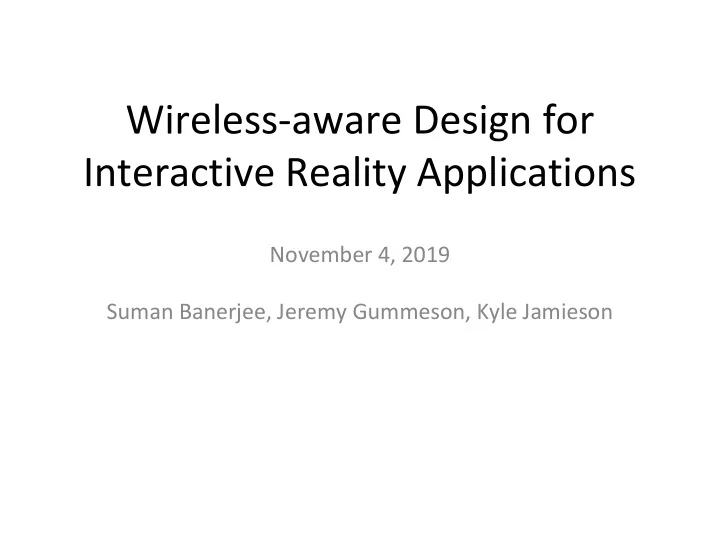

Wireless-aware Design for Interactive Reality Applications November 4, 2019 Suman Banerjee, Jeremy Gummeson, Kyle Jamieson
Participants Nirwan Ansari NJIT Monisha Ghosh National Science Foundation Maria Gorlatova Duke University Tao Han UNC Charlotte Ahmed Ibrahim Florida International University Shweta Jain CUNY Yao Liu SUNY Binghamton Alex Sprintson National Science Foundation Srinivas Shakkottai Texas A&M University Srinivasan Seshan Carnegie Mellon University Wei Wang San Diego State University Sheng Wei Rutgers Murat Yuksel University of Central Florida Hongwei Zhang Iowa State University
Applications • Live streaming interactive 360-degree videos • Augmented reality (more uplink) – Markups – Virtual objects, beings • Mixed reality • Virtual reality (more downlink)
Applications • Live streaming interactive 360-degree videos H o w t p o o • Augmented reality m r t a a k b – Markups e l e m , – Virtual objects, beings w o b e a i l e r a , b l • Mixed reality e ? • Virtual reality
Application Requirements • Latency, driven by perceptual, physiological requirements ( Quality of Experience ) – 1 to 15ms, depending on application, modality • Tradeoff: Network throughput versus on-device computation • Power constraints – Heat dissipation constraints, Battery Lifetime • • Support for multiple users in a shared space
Opportunities for innovation • Edge computing architecture – How to share the custom hardware among apps? • Higher frequency bands (mmWave, Terahertz, Visible Light Communication) – Use of directionality, antenna design, mobility • Managing QoE across applications in a multi-application environment • Low Power Design for Mobiles, Wearables, Headsets
Tools required • Applications – Prediction of user motion (head, eyes, user) with VR context – Prediction of content • Lower layers – Prediction of wireless channel – QoE-aware design of networking stack – Scheduling network and compute jointly
Tools required J o • Applications i n a t p – Prediction of user motion (head, eyes, user) with c p o l n i c VR context s a i d t i e o – Prediction of content r n a s t i a o n n d a • Lower layers l c o r w o s e – Prediction of wireless channel s r l a – QoE-aware design of networking stack y e r – Scheduling network and compute jointly s
Summary - Interactive reality applications are among the most challenging - Need for joint design: a. Across application and lower layers , b. Between device, edge, and cloud, and c. Between compute (CSR) and communication (NeTS)
Recommend
More recommend